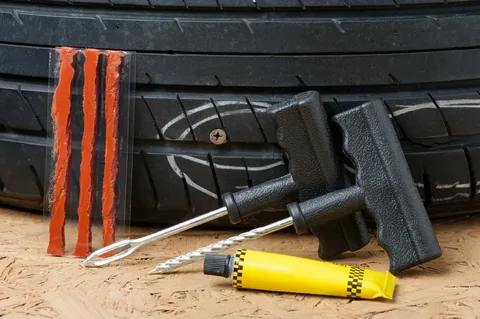The Ultimate Guide to Choosing the Best 4x4 Tire Repair Kit

Picture this: you’re on an exhilarating off-road adventure, the sun shining bright and the dirt trails beckoning. Suddenly, you hear that dreaded hiss—your 4x4 tyre has succumbed to a puncture. Panic sets in as thoughts race through your mind. Do you have what it takes to tackle this unexpected challenge? That’s where a trusty tyre repair kit steps into the spotlight! This guide will unravel everything you need to know about selecting, maintaining, and diagnosing issues with your 4x4 tire repair kit so you're always ready for action.
Understanding the 4wd Tyre Puncture Repair Kit
A 4WD tyre puncture repair kit is your adventure companion, ready to save the day when you least expect it. It’s a compact arsenal with tools and materials to tackle unexpected tyre troubles on those winding backroads.
At its core, a quality repair kit typically includes items like tyre plugs, adhesive sealants, and reaming tools. Each component is crucial in sealing punctures that could leave you stranded miles from civilisation.
Consider the tyre plug—a small yet mighty hero! This flexible rubber insert fills holes caused by nails or sharp objects, preventing air from escaping while allowing you to continue your journey without skipping a beat.
Don’t forget about sealants, either. These magical liquids can flow inside tyres and create an airtight barrier against leaks—even those small ones that try to ruin your fun over time.
Look for kits that include essential accessories such as valve stem removers and pressure gauges. Together, they enhance usability and ensure you're fully prepared for whatever rugged path lies ahead!
How to Tell If Your 4x4 tyre Repair is Bad?
A well-executed 4x4 tyre repair can save you from troubles on the road, but how do you know if it’s gone wrong? First, keep an eye out for visible signs. If your tyre has bulges or deformities after a repair, it’s waving a red flag.
Next is air pressure. A sudden drop in psi can indicate that the seal isn't holding. Check frequently; something's wrong if you’re pumping air more often than usual.
Listen closely to your tyres while driving. Any hissing sounds could mean leaks and bad repairs may also lead to strange vibrations. Your vehicle should feel smooth; anything else requires investigation.
Don’t ignore uneven wear patterns either—they often signal poor alignment or a failing 4x4 Tire Repair job. Inspecting tread depth regularly helps catch these issues early.
Trust your gut! If your 4x4's performance feels off after repair, don’t hesitate to dig deeper or consult a professional mechanic for peace of mind before hitting those rugged trails again!
Is a Bad Repair Kit Affecting Your Car’s Performance?
A lousy repair kit can leave you stranded in the middle of nowhere. Imagine tackling rugged trails with a tyre that’s poorly patched. That puncture could quickly become a blowout, putting your entire vehicle and safety at risk.
When you're off-roading, every component matters. A subpar tyre repair kit can lead to uneven pressure or improper hole sealing. This imbalance affects handling and stability, making your ride bumpy and unpredictable.
Think about it: a compromised repair means increased friction and wear on other parts of your vehicle, too. The engine works harder to compensate for poor traction, leading to decreased fuel efficiency over time. As you battle declining performance, you may notice more frequent trips to the gas station.
Moreover, an ineffective patch could allow dirt or moisture into the tyre structure. This contamination shortens the tyres' life and poses risks like corrosion—a silent enemy lurking beneath those treads.
In rough terrains where reliability is essential, trusting a malfunctioning repair kit might spell disaster when faced with unexpected challenges on the road ahead.
Diagnosing the Repair Kit Issues
When your tyre repair kit shows signs of wear, diagnosing the issues quickly can prevent more serious problems. First, take a close look at the sealant. If it appears dried out or clumpy, it's time for a replacement. A fresh sealant is crucial for ensuring that punctures are sealed effectively.
Next, inspect the tools included in your kit. Are they rusted or missing? Each tool serves a specific purpose during an emergency repair. Having reliable tools can mean the difference between getting back on the trail and being stranded.
Check any inflator components as well. If they’re not functioning correctly, you could have a flat tyre instead of a quick fix. An inflator that struggles to work may compromise your entire repair effort.
Remember about storage conditions—has moisture made its way into your kit? Water exposure can damage sealants and tools.
If applicable, monitor expiration dates; outdated products won’t perform when you need them most! Regularly assessing these aspects will help ensure you're always ready for the adventure ahead.
Installing a New Repair Kit
Installing a new tyre repair kit can feel like an adventure in itself. First, gather all your tools and find a well-lit space to work in. A clean area ensures that no dirt or debris interferes with the installation process.
Next, carefully remove the old repair kit from its storage location. Inspect each component for wear and tear; this step helps you understand what needs replacing. Don’t rush—taking time now saves hassle later.
When installing the new kit, read through any instructions provided thoroughly. Most kits include easy-to-follow guidelines that can save you time and frustration down the line.
As you organise your components, lay everything out methodically: sealant tubes beside puncture plugs and tools nearby. They should be within arm’s reach when needed. This organised approach will help streamline your repairs.
Double-check that all items are compatible with your specific tyres before re-sealing everything. Securely store the new repair kit in your vehicle so you're always prepared for unexpected encounters on rugged terrains!
Should You Replace Your 4wd Tyre Repair or Repair It?
Deciding whether to replace your 4WD tyre repair or attempt a fix can feel like navigating rough terrain. If your kit is old and showing signs of wear, replacement might be the better option. Modern kits often come with advanced technology and improved materials that enhance performance.
On the other hand, repairing your gear could save you money if you’ve used it only a couple of times and everything looks intact. Just make sure every component functions as intended before hitting the trail again. Regular inspections are essential for keeping your gear reliable.
Consider how frequently you venture off-road. If you're an avid adventurer who regularly tackles rugged paths, investing in a new kit may provide peace of mind during those challenging drives. A fresh set guarantees you'll face fewer hiccups along the way.
However, if off-roading is more of an occasional hobby for you, sticking with what you've got—if it's still functional—could work out just fine. Always weigh the cost against potential risks on unpredictable terrain.
Trust your instincts and assess each situation individually. Sometimes, patching things up makes great sense, while other times, calling for reinforcements pays off!
Top 5 Tips to Extend the Life of Your Repair Kit
To keep your tyre repair kit ready for action, start by storing it in a cool, dry place. Extreme temperatures can weaken the materials and affect their performance. A dedicated storage spot ensures everything is organised and easy to find.
Regularly check the components of your kit. Inspect items like plugs, sealants, and tools for signs of wear or expiration. By monitoring their condition, you’ll be prepared when emergencies arise.
Practice using the repair kit at home before hitting rugged terrains. Familiarising yourself with each tool makes repairs quicker and less stressful when you're on the trail. Plus, it adds a bit of confidence to your off-roading adventures.
After every use, clean your repair tools thoroughly. Dirt and debris can compromise functionality, leading to potential failures during critical moments. A quick wash can help preserve their quality.
Consider investing in a high-quality replacement part as needed. If any item seems worn or damaged after multiple uses, don't hesitate to replace it promptly—your safety depends on having reliable gear!
Conclusion
Choosing the right 4x4 tire repair kit is essential for every off-road enthusiast. It’s your lifeline on rugged trails, where punctures can happen when you least expect them. The peace of mind a reliable repair kit provides cannot be overstated. Your adventures deserve the best preparation. Investing in quality tools and materials ensures you're ready to tackle challenges head-on. After all, being stranded with a flat tyre far from civilisation isn't an experience anyone looks forward to. Remember, it’s not just about having any repair kit; it's about selecting one that meets your specific needs and preferences.
FAQS
What should I include in my 4x4 tire repair kit?
A well-rounded 4x4 tire repair kit generally includes puncture plugs, adhesives, an air compressor, valve stems, and installation tools like pliers and cutters. You want to be prepared for various types of damage.
How often should I check my tyre repair kit?
It is wise to inspect your kit at least twice a year or before embarking on long trips. This ensures that all components are functional and ready when needed.
Can I use any sealant with my repair kit?
Not all sealants are created equal! Stick to those recommended by your specific repair kit manufacturer. Using incompatible products can lead to further damage.
Is it safe to drive after repairing a punctured tyre?
Driving short distances is usually fine if performed correctly using quality materials from your tyre repair kit. However, it is always best to have a professional evaluate it afterwards for safety reasons.
What's the lifespan of a typical tyre repair kit?
Most kits last several years if stored correctly, but individual parts may need to be replaced depending on usage and environmental factors.
|
Related Business Listings |






